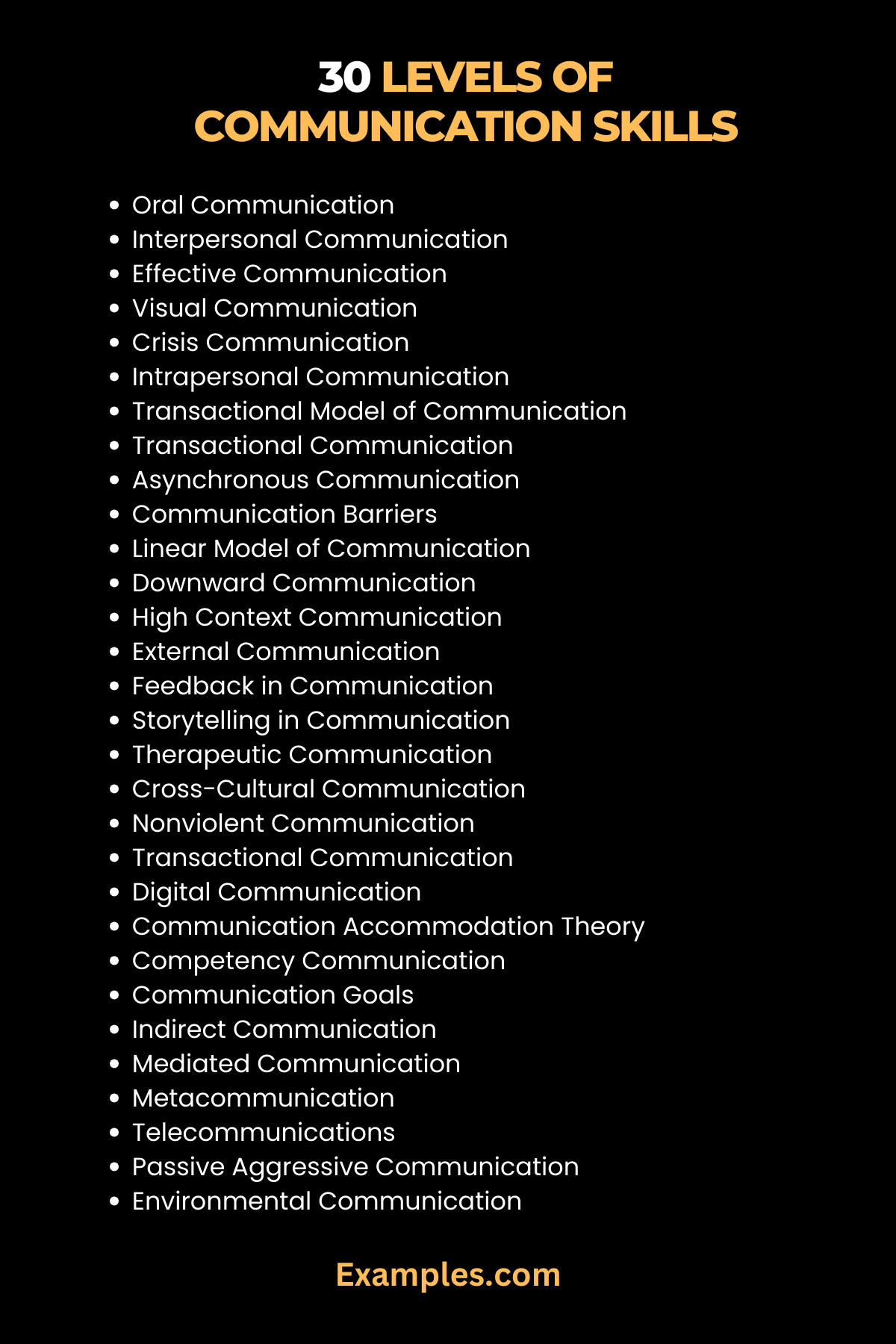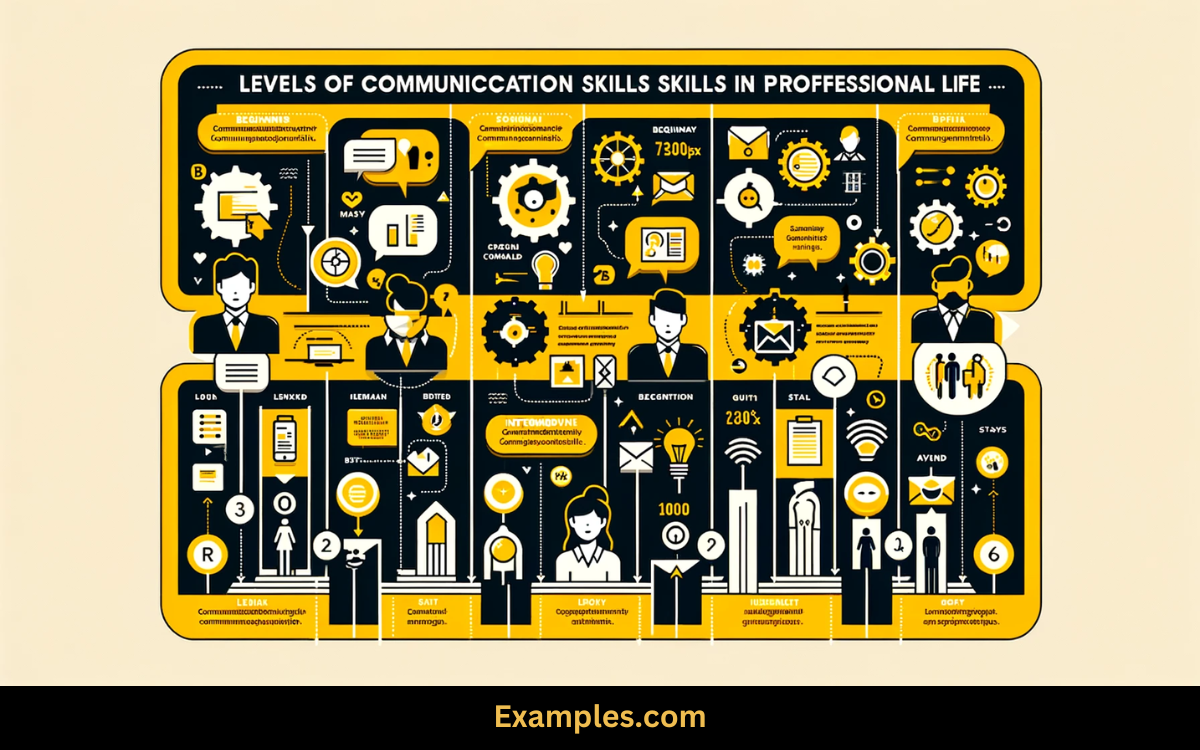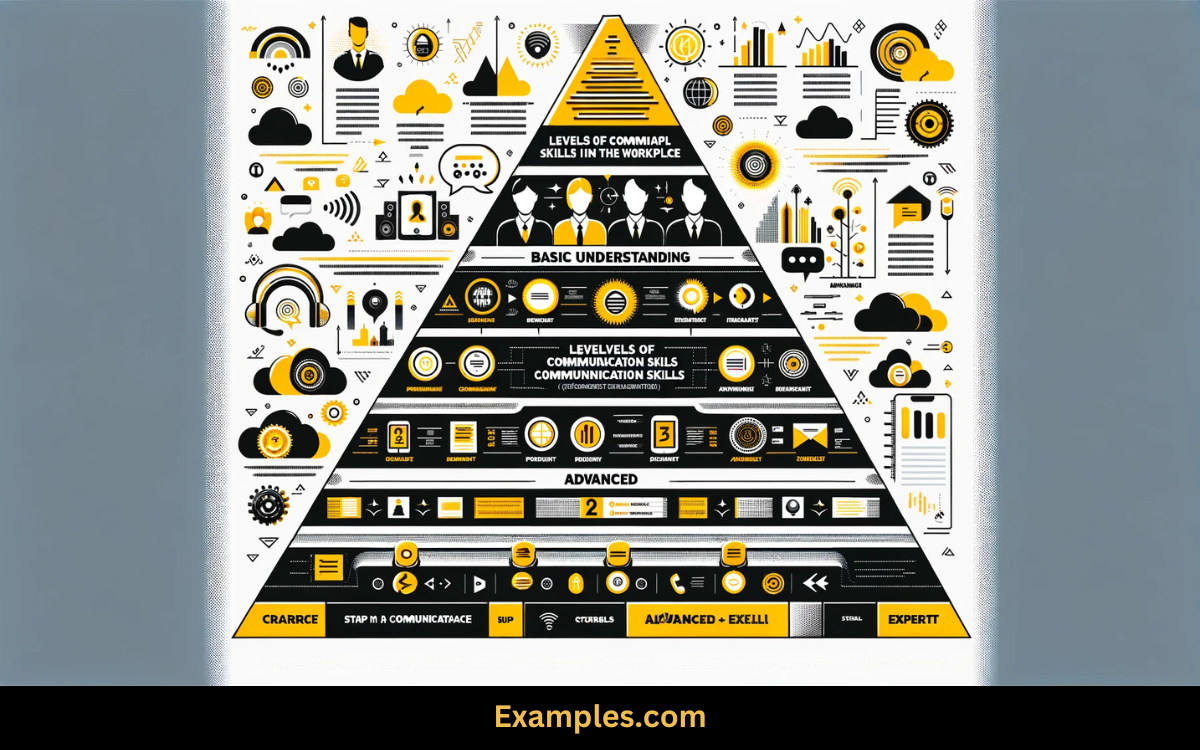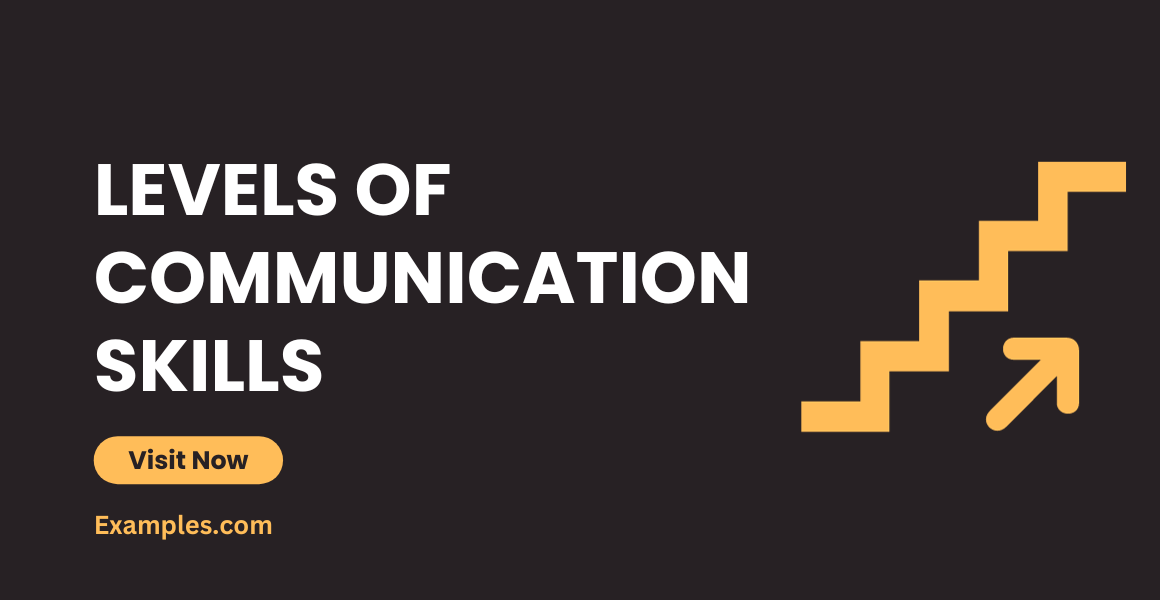29+ Levels of Communication Skills Examples
Unlock the intricacies of effective communication as we delve into the comprehensive “Levels of Communication Skills” guide. This resource navigates through various aspects, providing insightful Communication Examples to illuminate each level. From professional resumes to dynamic workplace interactions, our guide offers practical tips and a deep dive into the nuances of interpersonal connections. Elevate your communication prowess with this indispensable guide, tailored for success in both personal and professional realms.
30 Examples of Levels of Communication Skills
Embark on a transformative journey through our comprehensive guide on “30 Levels of Communication Skills Examples.” Immerse yourself in the world of effective communication, enriched with practical insights and keyword-rich content tailored for success in various contexts. Unveil the intricacies of oral, written, and visual communication, along with strategies for navigating cross-cultural interactions and overcoming barriers. Elevate your interpersonal dynamics with this SEO-friendly resource designed to empower your communication prowess.

- Oral Communication: Master public speaking to engage and persuade diverse audiences with clarity and confidence.
- Interpersonal Communication: Navigate complex social dynamics by cultivating active listening and fostering genuine connections.
- Effective Communication: Craft compelling messages that resonate with your audience, fostering understanding and cooperation.
- Visual Communication: Harness the power of infographics and presentations to convey complex ideas in a visually appealing manner.
- Crisis Communication: Address challenging situations by providing transparent and timely information to stakeholders.
- Intrapersonal Communication: Develop self-awareness and self-reflection for improved decision-making and emotional intelligence.
- Transactional Model of Communication: Understand the cyclical nature of communication, recognizing feedback loops for effective dialogue.
- Transactional Communication: Build mutually beneficial relationships by fostering open and reciprocal communication with others.
- Asynchronous Communication: Embrace flexibility in communication through emails and messaging platforms to bridge time differences.
- Communication Barriers: Identify and overcome obstacles such as language differences, cultural nuances, and perceptual filters.
- Linear Model of Communication: Grasp the sequential steps of encoding, transmission, and decoding for effective message delivery.
- Downward Communication: Transmit organizational goals and expectations to team members, ensuring alignment and clarity.
- High Context Communication: Navigate cultural subtleties by understanding unspoken cues and context in communication.
- External Communication: Establish credibility with external stakeholders through transparent and consistent communication.
- Feedback in Communication: Create a culture of constructive feedback to foster continuous improvement and growth.
- Storytelling in Communication: Craft narratives that captivate audiences, making information memorable and relatable.
- Therapeutic Communication: Enhance patient care by practicing active listening, empathy, and clear communication in healthcare settings.
- Cross-Cultural Communication: Bridge cultural gaps by adapting communication styles to honour and respect diverse perspectives.
- Nonviolent Communication: Resolve conflicts peacefully by expressing needs and feelings assertively, promoting understanding.
- Transactional Communication: Engage in reciprocal interactions to build rapport, trust, and shared understanding with others.
- Digital Communication: Leverage various digital platforms and tools for efficient and real-time information sharing.
- Communication Accommodation Theory: Adjust your communication style to connect effectively with individuals from different backgrounds.
- Competency Communication: Demonstrate expertise through clear and confident communication, establishing professional credibility.
- Communication Goals: Set clear objectives to guide communication efforts and achieve desired outcomes in personal and professional contexts.
- Indirect Communication: Navigate subtle communication by conveying messages tactfully while maintaining transparency.
- Mediated Communication: Utilize technology to facilitate communication across different mediums, enhancing accessibility and efficiency.
- Metacommunication: Discuss the communication process itself during interactions, ensuring mutual understanding.
- Telecommunications: Explore advanced communication technologies for seamless long-distance connections and collaborations.
- Passive Aggressive Communication: Address concerns assertively, fostering open communication rather than resorting to passive-aggressive approaches.
- Environmental Communication: Effectively convey messages about environmental issues to inspire positive action and awareness.
Levels of Communication Skills in Professional Life
Unlock the secrets to thriving in your professional journey with a deep dive into the diverse “Levels of Communication Skills in Professional Life.” Navigate workplace intricacies, master client interactions, and enhance leadership communication to propel your career forward. Elevate your ability to articulate ideas, negotiate effectively, and foster collaborative environments.

- Email Etiquette: Craft concise, professional emails for effective communication in a corporate setting.
- Leadership Communication: Inspire and motivate teams through clear, visionary communication strategies.
- Client Presentations: Convey complex information succinctly to engage and impress clients and stakeholders.
- Meeting Facilitation: Lead productive meetings by fostering open communication and collaboration.
- Negotiation Skills: Navigate negotiations confidently, balancing assertiveness and cooperation.
- Conflict Resolution: Address workplace conflicts diplomatically to maintain a harmonious professional environment.
- Cross-Functional Communication: Collaborate seamlessly across departments, ensuring a unified organizational vision.
- Project Updates: Communicate project progress effectively, highlighting key achievements and addressing challenges.
- Professional Networking: Build meaningful professional relationships through effective networking communication.
- Executive Presence: Develop a commanding presence through polished communication, instilling confidence in your leadership.
Levels of Communication Skills in Resume
Craft a compelling professional narrative with our guide on “Levels of Communication Skills in Resume.” Elevate your resume with impactful communication keywords, showcasing your ability to communicate effectively across various contexts and industries.

- Strategic Communication: Developed and executed strategic communication plans to enhance team collaboration.
- Quantifiable Achievements: Increased client satisfaction by 20% through clear and concise communication strategies.
- Multilingual Proficiency: Fluent in English, Spanish, and French, facilitating global communication.
- Team Collaboration: Fostered a collaborative work environment by enhancing team communication and cohesion.
- Client Relationship Management: Established and maintained strong client relationships through effective communication.
- Technical Communication: Translated complex technical concepts into user-friendly documentation for diverse audiences.
- Presentation Skills: Delivered engaging presentations at industry conferences, showcasing thought leadership.
- Adaptability: Successfully communicated across diverse cultures, adapting communication style to local nuances.
- Social Media Communication: Managed company social media accounts, engaging audiences through compelling communication.
- Detail-Oriented Communication: Ensured accuracy and clarity in all written and verbal communication to enhance organizational efficiency.
Levels of Communication Skills in the Workplace
Navigate the intricacies of workplace dynamics with our guide on “Levels of Communication Skills in the Workplace.” From team collaboration to effective leadership communication, enhance your workplace interactions for professional success.

- Team Building Communication: Fostered a positive team culture through open and transparent communication channels.
- Feedback Integration: Actively sought and integrated constructive feedback to improve team communication dynamics.
- Conflict Management: Addressed interpersonal conflicts promptly, fostering a harmonious workplace environment.
- Adaptive Leadership: Communicated organizational changes effectively, ensuring smooth transitions for the team.
- Task Delegation: Clearly communicated tasks and expectations to team members, optimizing workflow efficiency.
- Time Management Communication: Established clear communication channels for project timelines, meeting deadlines consistently.
- Collaborative Decision-Making: Engaged teams in decision-making processes, ensuring diverse perspectives were considered.
- Remote Work Communication: Successfully adapted communication strategies to the challenges of remote work, fostering team connectivity.
- Employee Recognition: Acknowledged and celebrated team achievements through effective and appreciative communication.
- Leadership Transparency: Maintained open communication about organizational goals, fostering a transparent work culture.
What are the 5 Levels of Communication?
Communication is a multifaceted process, and understanding its various levels is essential for effective interaction. Explore the intricacies of the “5 Levels of Communication” to enhance your interpersonal skills and navigate diverse contexts.
- Intrapersonal Communication: Intrapersonal communication involves self-talk and internal dialogue. Explore techniques for self-reflection, self-awareness, and enhancing your inner dialogue to optimize personal growth.
- Interpersonal Communication: Delve into the dynamics of one-on-one communication. Learn the art of active listening, expressing emotions effectively, and fostering meaningful connections in both personal and professional relationships.
- Group Communication: Navigate the complexities of communicating within groups. Master the skills of facilitation, conflict resolution, and collaboration to ensure effective communication in team settings.
- Public Communication: Develop your ability to address larger audiences. Explore strategies for crafting compelling messages, delivering impactful presentations, and engaging diverse audiences in various public speaking scenarios.
- Mass Communication: Understand the nuances of communicating with a broad, diverse audience through mass media channels. Explore the principles of effective mass communication, including media literacy and audience engagement.
What are the Four 4 Types of Communication According to Context?
Communication takes on different forms depending on the context and purpose. Explore the four fundamental types of communication, each tailored to specific situations and objectives.
- Verbal Communication: Dive into the world of spoken or written words. Enhance your verbal communication skills through clear articulation, effective language use, and the ability to convey messages with precision.
- Nonverbal Communication: Explore the silent language of gestures, facial expressions, and body language. Master the art of nonverbal communication to convey emotions, intentions, and enhance overall message effectiveness.
- Visual Communication: Understand the power of visuals in conveying information. From graphs and charts to presentations and infographics, learn to use visual aids to enhance clarity and engagement in various communication contexts.
- Written Communication: Explore the nuances of written expression. Develop skills in crafting emails, reports, and other written documents with clarity, coherence, and impact.
In conclusion, mastering the diverse “Levels of Communication Skills” is pivotal for success. This comprehensive guide has equipped you with insights, practical examples, and tips to navigate professional and personal communication challenges. From interpersonal dynamics to effective workplace interactions, empower yourself with the knowledge to articulate ideas, build relationships, and thrive in diverse communication scenarios.



